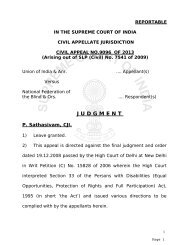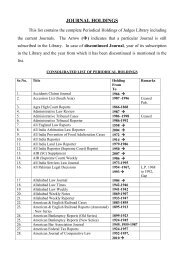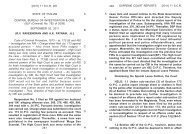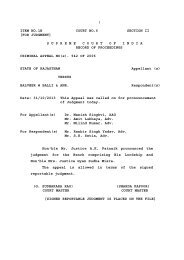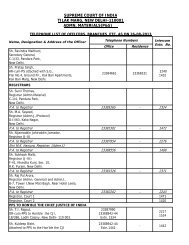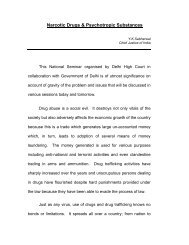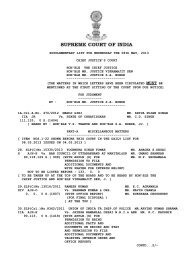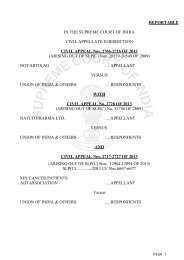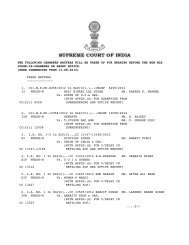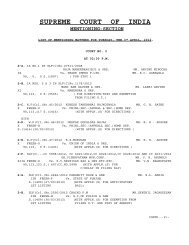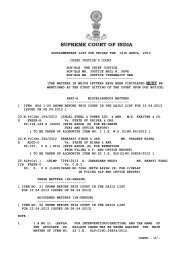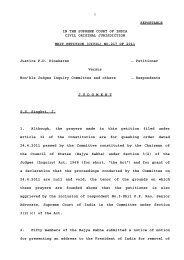Part No.IV - Supreme Court of India
Part No.IV - Supreme Court of India
Part No.IV - Supreme Court of India
Create successful ePaper yourself
Turn your PDF publications into a flip-book with our unique Google optimized e-Paper software.
SARADAMANI KANDAPPAN v. S. RAJALAKSHMI &<br />
ORS. [R.V. RAVEENDRAN, J.]<br />
<strong>of</strong> the parties, nature <strong>of</strong> the property and surrounding<br />
circumstances, it is not inequitable to grant such relief. [vide<br />
Gomathinayagam Pillai (supra), Govind Prasad Chaturvedi<br />
(supra) and Indira Kaur v. Sheo Lal Kapoor – 1988 (2) SCC<br />
188 and Chand Rani (supra) following the decision <strong>of</strong> Privy<br />
Council in Jamshed Khodaram Irani v. Burjorji Dhunjibhai – AIR<br />
1915 PC 83 and other cases]. Of course, the Constitution<br />
Bench in Chand Rani made a slight departure from the said<br />
view.<br />
24. The principle that time is not <strong>of</strong> the essence <strong>of</strong><br />
contracts relating to immovable properties took shape in an era<br />
when market value <strong>of</strong> immovable properties were stable and<br />
did not undergo any marked change even over a few years<br />
(followed mechanically, even when value ceased to be stable).<br />
As a consequence, time for performance, stipulated in the<br />
agreement was assumed to be not material, or at all events<br />
considered as merely indicating the reasonable period within<br />
which contract should be performed. The assumption was that<br />
grant <strong>of</strong> specific performance would not prejudice the vendordefendant<br />
financially as there would not be much difference in<br />
the market value <strong>of</strong> the property even if the contract was<br />
performed after a few months. This principle made sense<br />
during the first half <strong>of</strong> the twentieth century, when there was<br />
comparatively very little inflation, in <strong>India</strong>. The third quarter <strong>of</strong><br />
the twentieth century saw a very slow but steady increase in<br />
prices. But a drastic change occurred from the beginning <strong>of</strong> the<br />
last quarter <strong>of</strong> the twentieth century. There has been a galloping<br />
inflation and prices <strong>of</strong> immovable properties have increased<br />
steeply, by leaps and bounds. Market values <strong>of</strong> properties are<br />
no longer stable or steady. We can take judicial notice <strong>of</strong> the<br />
comparative purchase power <strong>of</strong> a rupee in the year 1975 and<br />
now, as also the steep increase in the value <strong>of</strong> the immovable<br />
properties between then and now. It is no exaggeration to say<br />
that properties in cities, worth a lakh or so in or about 1975 to<br />
1980, may cost a crore or more now.<br />
919 920<br />
A<br />
B<br />
C<br />
D<br />
E<br />
F<br />
G<br />
H<br />
A<br />
B<br />
C<br />
D<br />
E<br />
F<br />
G<br />
H<br />
SUPREME COURT REPORTS [2011] 8 S.C.R.<br />
25. The reality arising from this economic change cannot<br />
continue to be ignored in deciding cases relating to specific<br />
performance. The steep increase in prices is a circumstance<br />
which makes it inequitable to grant the relief <strong>of</strong> specific<br />
performance where the purchaser does not take steps to<br />
complete the sale within the agreed period, and the vendor has<br />
not been responsible for any delay or non-performance. A<br />
purchaser can no longer take shelter under the principle that<br />
time is not <strong>of</strong> essence in performance <strong>of</strong> contracts relating to<br />
immovable property, to cover his delays, laches, breaches and<br />
‘non-readiness’. The precedents from an era, when high<br />
inflation was unknown, holding that time is not <strong>of</strong> the essence<br />
<strong>of</strong> the contract in regard to immovable properties, may no longer<br />
apply, not because the principle laid down therein is unsound<br />
or erroneous, but the circumstances that existed when the said<br />
principle was evolved, no longer exist. In these days <strong>of</strong> galloping<br />
increases in prices <strong>of</strong> immovable properties, to hold that a<br />
vendor who took an earnest money <strong>of</strong> say about 10% <strong>of</strong> the<br />
sale price and agreed for three months or four months as the<br />
period for performance, did not intend that time should be the<br />
essence, will be a cruel joke on him, and will result in injustice.<br />
Adding to the misery is the delay in disposal <strong>of</strong> cases relating<br />
to specific performance, as suits and appeals therefrom<br />
routinely take two to three decades to attain finality. As a result,<br />
an owner agreeing to sell a property for Rs.One lakh and<br />
received Rs.Ten Thousand as advance may be required to<br />
execute a sale deed a quarter century later by receiving the<br />
remaining Rs.Ninety Thousand, when the property value has<br />
risen to a crore <strong>of</strong> rupees.<br />
26. It is now well settled that laws, which may be<br />
reasonable and valid when made, can, with passage <strong>of</strong> time<br />
and consequential change in circumstances, become arbitrary<br />
and unreasonable.<br />
26.1) In Rattan Arya v. State <strong>of</strong> Tamil Nadu – (1986) 3<br />
SC 385, this <strong>Court</strong> held:



